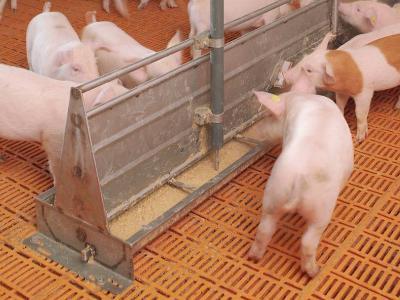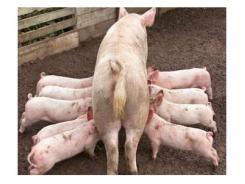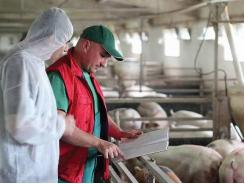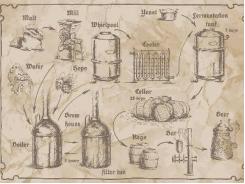Fermented liquid pig feed benefits outweigh drawbacks

Liquid feeding is a technique that appears easy but requires a steep learning curve for staff. | Big Dutchman
An alternative method to offering dry or just liquid feeds that suits antibiotic-free production systems
Along with a continuous trend towards more liquid feeding systems being installed throughout the world, there is an increasing interest in feeding fermented liquid feed to pigs. Fermented liquid feed is not just feed steeped in water; it’s one step beyond that. In brief, liquid diets such as those used under normal liquid feeding practices are allowed to ferment for a certain period of time in the mixing tank before being fed to pigs. Of course, this is an elaborate process requiring careful monitoring and considerable experience, but the benefits appear to outweigh any disadvantages, at least in most cases.
One of the biggest advantages of fermented liquid feeding is better gut health. Indeed, research in Great Britain and elsewhere has demonstrated that fermented liquid feed significantly decreases coliform counts and incidences of Salmonella along the gastrointestinal tract of pigs. This is because fermented liquid feed is more acidic (pH 3-4) compared to unfermented liquid feed (pH 6-8). It has also been indicated that soaking of feed for at least 9 hours also improves digestibility of phosphorus, among other nutrients, and it might also improve feed palatability.
The most optimum conditions for fermenting liquid pig feed are eight hours of fermentation at 20C.
A review of trials regarding the effects of feeding liquid diets to pigs indicated that feeding fermented liquid feed improves weight gain by 22 and 13 percent over dry and unfermented liquid feed, respectively. Surprisingly, in both cases, feed efficiency has been found always inferior (-4 to -11 percent for liquid and fermented liquid feeding, respectively) compared to dry feeding, which can be attributed to increased wastage (perhaps due to unresolved distribution problems at that time) and (or) reduced protein quality (especially lysine) in fermented feed.

A review of trials regarding the effects of feeding liquid diets to pigs indicated that feeding fermented liquid feed improves weight gain by 22 and 13 percent over dry and unfermented liquid feed, respectively.
The negative aspects of fermented liquid feeding focus around the need for considerable experience before this practice can be applied successfully. For example, insufficient fermentation can actually lead to increased pathogen populations in feed. Fluctuations in temperature greatly affect the fermentation process, as does the introduction of cold water especially during the winter months. Finally, the problem of reduced protein quality because of bacterial use of dietary amino acids and (or) formation of Maillard reaction products during fermentation definitely increase feed cost as they are currently being addressed via over-formulation. Finally, feed medication can not be practiced with fermented liquid feeding as it greatly affects the proliferation of beneficial bacteria during fermentation. On the other hand, in-feed medication seems superfluous as feed acidity is hostile to pathogen proliferation in the gut. As such, fermentation and antibiotic-free systems are a good match.
The process
The whole idea of fermenting liquid feed is based on the fact that lactic bacteria and yeasts naturally occurring in cereals will proliferate if feed is soaked in water for a certain period of time under the right temperature. The end result is a feed rich in lactic and acetic acids with a reduced pH, all of which are considered beneficial for gastrointestinal health. It is evident that during fermentation the microbial and chemical composition of the feed is significantly altered.

Presented here is a comparison of chemical and microbiological differences between dry, liquid and fermented liquid feed.
Studies carried out in Denmark and the UK demonstrated that the most optimum conditions for fermenting liquid pig feed are eight hours of fermentation at 20C. For the fermentation process to continue, it is imperative that at least 50 percent of fermented feed be used as “seed” for the next batch of feed. This dictates that mixing/fermentation tank capacity be at least double of what is required for one normal feeding episode. These conditions will produce feed with a maximum pH value of 4.5 and very low levels of coliform bacteria. Lower temperatures favor the development of yeasts and cold-resistant coliform bacteria that become increasingly resilient to low pH.
It should be noted that during the first hours of fermentation (starting without “seed”), the number of coliform bacteria actually increase. But, given enough time, their density drops quickly as the concentration of lactic acid increases to levels that first inhibits growth and then eliminates coiforms. It is estimated that it takes at least three days for the fermentation process to reach stability and be suitable for feeding to piglets, which are the most sensitive in terms of gut health.
To aid the initiation of the fermentation process and enhance stability, it is often suggested that a starter culture be used during the first three days. This includes bacteria species beneficial to the fermentation process, such as Lactobacilus alimentarious, Pediococcus acidilactici, and Lactobacillus plantarum, usually found as commercial products. Although such a preparation definitely adds to the strength of the process, it offers no further benefits once the system reaches stability.
Summing up
In brief, fermenting liquid feed requires a steep learning curve but can easily become streamlined once the system reaches stability. The benefits appear to outmatch the shortcomings, especially in antibiotic-free production systems. Nevertheless, fermented liquid feeding remains an expensive investment that needs to be balanced against its advantages.
See this list of six industrial by-products for liquid feeding pigs
Ioannis Mavromichalis, Ph.D., is Nutrition Editor for WATTAgNet and Editor-in-Chief of Pig International.
Có thể bạn quan tâm
Phần mềm

Phối trộn thức ăn chăn nuôi

Pha dung dịch thủy canh

Định mức cho tôm ăn

Phối trộn phân bón NPK

Xác định tỷ lệ tôm sống

Chuyển đổi đơn vị phân bón

Xác định công suất sục khí

Chuyển đổi đơn vị tôm

Tính diện tích nhà kính

Tính thể tích ao hồ




 How liquid feeding improves piglet gut health
How liquid feeding improves piglet gut health  7 questions to ask your animal feed yeast…
7 questions to ask your animal feed yeast…